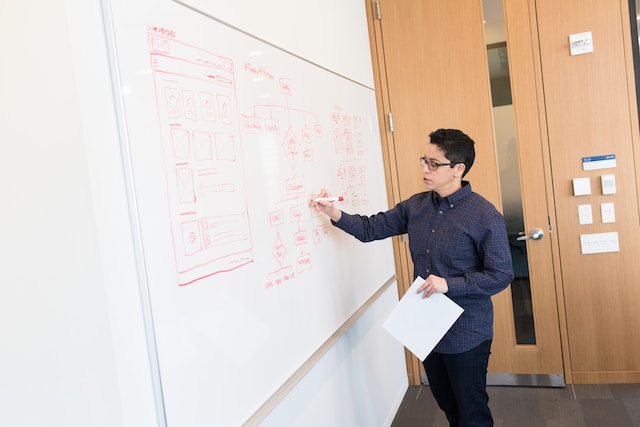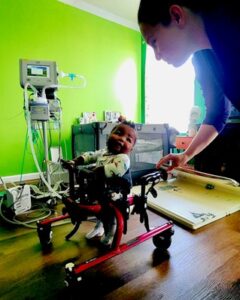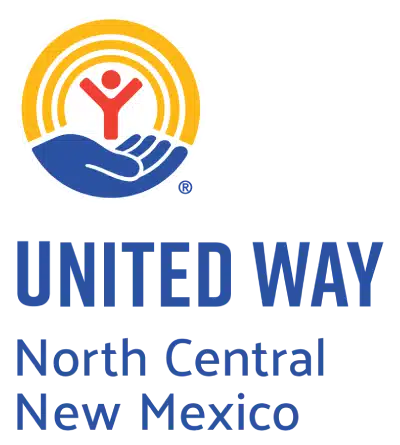



Education-Friendly Workplace Best Practices
Learn about ed-friendly practices, polices and resources
Click the titles below to learn more about each topic
Education Friendly Practices, Polices and Resources
Workplace Culture Practices
1st Phase
Incorporate a commitment to employee educational attainment into your mission and vision statements.
2nd Phase
Align the employees’ education and development to the organizations’ ability to achieve its mission.
3rd Phase
Document and advertise educational benefits, supports, and programs.
1st Phase
Document and share the goal of higher education attainment for your employees.
2nd Phase
Introduce educational benefits, goals, programs, and support during on-boarding and employee training.
3rd Phase
Align education goals to annual performance evaluation and document education support plans.
1st Phase
Rethink old “minimum” qualifications, allowing people without traditional degrees or experience to demonstrate affinity and openness to learn.
2nd Phase
Provide extensive training and support for skill development as part of on-boarding.
3rd Phase
Commit to working with new hires’ schedule of external education commitments.
1st Phase
Create career ladders of opportunities and trajectories tied to upskilling and credential/degree attainment.
2nd Phase
Introduce/share career ladders during on-boarding, training, and performance evaluations.
3rd Phase
Honor career ladder advancement with promotion and increased benefits & salary.
1st Phase
Announce & publish employee participation and completion of educational opportunities.
2nd Phase
Apply for the Family Friendly New Mexico Business Award and Education Support Special Designation.
3rd Phase
Host a gathering to acknowledge and celebrate educational attainment.
Tangible Support and Opportunites
1st Phase
The Graduate! Network Education Benefits Calculator
2nd Phase
Establish college savings and/or lifelong learning accounts as payroll deduction benefits. NM 529 Savings Plan
3rd Phase
Support or subsidize training/education/tuition assistance, such as professional development opportunities and tuition, course, book, or fee assistance.
1st Phase
Provide flexible scheduling to accommodate coursework and enrollment.
2nd Phase
Ad hoc arrangements: allowing employees to leave early on exam days or to attend a daytime lecture.
3rd Phase
Formal arrangements such as a four-day work week.
1st Phase
Devote time for staff to share about their educational journeys.
2nd Phase
Designate a staff member to assist with educational advising (goal setting, warm-handoffs to partners, navigating benefits).
3rd Phase
Develop workplace mentoring and leadership programs for those seeking educational opportunities.
1st Phase
Actively encourage, support and reward skill development and help navigate employee participation in existing educational opportunities such as LinkedIn Learning.
2nd Phase
Partner with education/training institutions to promote external educational opportunities. Ex: Host education and resource fairs or refer employees to local advisor.
3rd Phase
Partner with education/training institution for tailored and certified workshops and in-house training. May include access to ESL, High School Equivalency (HSE), and aligned skills/certifications/degrees.
Education-friendly practices & policies should be supported by underlying and complimentary family-friendly policies.
- Paid Leave
- Health Support
- Work Schedules
- Economic Support
Visit Family Friendly New Mexico to learn more about these policies, download toolkits, and apply for the Family Friendly Business Award and the Education Support Special Designation.
Policy & Resources
How can our organization implement education support policies?
- Identify organizational priorities and objectives.
- How might these be tied to increasing employee training and education?
- Which institutions/programs/partners might assist with these?
- Calculate potential costs
- Avg. costs of courses, expected number of participants, expected ROI
- Estimate redirected time & effort
- The Graduate! Network Education Benefits Calculator
- Identify desired level of assistance and create budget
- Low-cost local partnerships, utilizing NM Opportunity Scholarship
- Tuition coverage or reimbursement for one course per semester
- Create policy which includes a description of the benefits, qualifications, requirements
- Promote, market, and support employee access to benefits
- Identify staff member(s) to champion efforts, serve as mentors, navigators, or trainers
- Setting up Successful Internal Mentoring
- Uplift & celebrate employee educational milestones
- Create policy/plan to incorporate priority education and training-related language and goals to performance reviews
- Promote and support employees, particularly supervisors and leadership, in developing and following through with individual/departmental/organizational goals
- 5 Ways to Put Learning at the Center of Performance Reviews Guide
- Measure and monitor results, adjusting overtime
Subsidized Education Assistance | Employers provide coverage of or assistance with costs for career development opportunities, tuition, course fees, books, etc. |
Educational navigation, mentorship, & leadership training | Provide internal guidance and support to help employees identify goals and navigate educational and career advancement opportunities. UNM Health Staff Mentorship Program |
In-house offerings & partnerships | In-house offerings and partnerships to provide tailored services, training, and educational opportunities. |
Performance reviews and goals | Incorporating educational and training goals into performance reviews. Put Learning at the Center of Performance Reviews |
Advantages to an Ed-friendly workplace
Businesses are increasingly experiencing difficulty in finding and retaining talent. Fostering a workplace in which employees are valued, invested in, and who see opportunities for personal and professional growth can help organizations and businesses hire, develop, and retain skilled employees. This in turn increases productivity, quality production of goods and services, and drives profits.
In 2022, only 36.7% of working-age adults in New Mexico had an associate degree or higher. This lags behind the national average of 43.6% (US Census). There is a positive correlation between the workforce’s level of education, a state’s median wages, and productivity.
Talent is often an employer’s most critical asset when building and scaling their organization. When businesses and organizations strategically plan and invest in talent development, it’s a win-win for employers, employees, and the local economy and community.
- Assistance can include reimbursing, covering some, or all costs of tuition, workshops, courses.
- Tuition assistance programs are shown to increase employee satisfaction, reduce turnover, and lead to internal promotions
- Reduce business costs related to recruiting and onboarding caused by turnover. Calculate Costs of Employee Attrition & Turnover
- Employers can decide what and how much to cover depending on their needs and budgets, recouping costs with increasing loyalty, motivation/productivity, and internal promotion.
- Internal promotion rates increase and for front-line workers, employees participating stay with a company for at least two years while completing a degree – longer than usual in high-turnover positions.
- Showing commitment to and investment in the value and long-term prospects of employees increases morale and motivation.
- Employees are much more likely to begin and complete educational/training programs with support and mentoring
- Increased productivity, skill-set alignment, and internal promotion.
- Internal promotion is 18-20% less expensive than external hiring.
- Tailor offerings to specific needs and access industry-related credentials.
- Control the costs and scheduling of offerings.
- In-house activities contribute to team building and harness collective motivation and incentive to participate.
- Access support through partnering with local colleges (financial aid & application process).
- Partnerships may include special benefits such as early registration and individualized advising.
- Increase employee knowledge and utilization of educational and training benefits.
- Help employees, supervisors, and employers prioritize personal and career growth.
- Solve talent and skills gaps.
- Boost employee motivation, efficacy, morale, and loyalty.
Costs & Potential Challenges
Challenges
Addressing misconceptions that offerings are costly, time-consuming, or that employees will be lost to competitors.
- Assess needs and costs of options
- Utilize local programs and colleges to help minimize time spent planning/organizing
- Research show that skill building leads to reduced feelings of stagnation and attrition, as well as increasing employee loyalty
Ensuring employee buy-in
- Provide information, support and encouragement
- Provide mentorship opportunities for persistence and success
- Tie in skilling-up with performance goals and promotions
Addressing scheduling flexibility
- Many courses are now available online or in the evenings, helping to accommodate schedules
- Agree to communicate about upcoming exams etc. where a flexible schedule is needed
- Agree to provide a few on-site hours for coursework
- Agree to shift hours earlier/later to accommodate course times
Costs
Can vary depending on industry and extent of offerings
- NM Opportunity Scholarship helps reduce need to extensively cover tuition costs
- Start small with adjusting practices & policies as you build capacity
- Utilize opportunities for free programs such as Job Training Albuquerque
Calculate costs utilizing The Graduate! Network Education Benefits Calculator
Pros and Cons | employers vs. individuals
Employers
Individuals
Case Studies & Testimonials

United Way of North Central New Mexico – Supporting Educational Attainment and Family Stability for Staff and Community
United Way of North Central New Mexico – Supporting Educational Attainment and Family Stability for Staff and Community For 90

Abrazos Family Support Services – A History of Care & Quality in the Community
Abrazos Family Support ServicesA History of Care & Quality in the Community “With better training and education, we gain better

TLC Company Inc. – An Education-Friendly Workplace
TLC Company Inc. – An Education-Friendly Workplace “We’re investing in them because they’re investing in themselves.” Lisa Knapp Training Manager
Local Colleges, Partners & Programs
Partnerships with local or national institutions and programs can reduce the need for employer organization and management of educational opportunities. Local colleges have advisors to help support employees with applying for and accessing financial aid, arranging class schedules, and more. Additionally, in-house offerings offered by partners can be tailored to employers’ specific needs.
Browse the list of colleges, partners, and programs.
Central New Mexico Community College
New Mexico Highlands Santa Fe
Santa Fe Community College
Southwestern Indian Polytechnic Institute
University of New Mexico
UNM Valencia
For Employees: Financial Aid
Financial aid is money to help pay for a student’s higher education. Funds can come from the state, federal government, higher ed. institutions, or private funders such as non-profits and businesses. Costs such as tuition and fees, books and supplies, room and board, transportation, and some living expenses may be covered by financial aid. Funds typically come in the form of grants, scholarships, work-study, and loans.
Apply for federal & state financial aid by filling out the FAFSA – The Free Application for Federal Student Aid
Grants – Funds to pay for college or career training, typically given based on a student’s financial need. Grants do not need to be repaid.
Resources:
Scholarships – Funds to pay for college or career training, typically based on a student’s unique background, talents, interests, major etc. May be funded through the state government, higher education institution, or private entity such as a non-profit or business.
Resources:
NM Opportunity & Lottery Scholarships
Fire Fighters & Peace Officers Survivors Scholarship
Wartime & Vietnam Veterans Scholarship
Albuquerque Community Foundation Scholarships
UNM’s Additional Scholarship Website Resource
Work-study – Part-time work available to students with financial need, organized by the higher education institution and funded by state or federal government.
Resources:
Loans – Money that is given to a student to pay for college or career training and which must be paid back, including interest. Loans may come from federal or state government, or from private lenders.
Resources:
College Savings Plan – A tax-advantaged savings account for education expenses.
Resources:
Helpful Definitions
Learn the common terminology used in higher education settings.
Programs combine paid on-the-job training with related classroom instruction. NMDWS
A tax-advantaged savings account for education expenses
funds to pay for college or career training, typically given based on a student’s financial need. Grants do not need to be repaid.
The Free Application for Federal Student Aid – assesses an individual’s or family’s need for financial aid using recent tax returns. Filling out the FAFSA is the first step to accessing federal and state financial aid.
Money to help pay for a student’s higher education. Typically in the form of grants, scholarships, work-study, and loans from the state, federal government, higher ed. institutions, or private funders such as non-profits and businesses. Costs such as tuition and fees, books and supplies, room and board, transportation, and some living expenses may be covered.
A student or trainee who works at a trade or occupation in order to gain work experience.
Money that is given to a student to pay for college or career training and which must be paid back, including interest. Loans may come from federal or state government, or from private lenders. Subsidized vs Unsubsidized Loans
Education level following secondary (high school), including colleges, universities, trade & vocational schools.
Funds to pay for college or career training, typically based on a student’s unique background, talents, interests, major etc. May be funded through the state government, higher education institution, or private entity such as a non-profit or business.
A sum of money charged for teaching or instruction by a school, college, or university.
An employee benefit through which an employer pays for a pre-determined amount, either upfront or as a reimbursement, of continuing education, college coursework, etc. These programs are intended to assist employees in advancing their education as it relates to their current career track, offering the chance to increase industry knowledge and develop advanced skills.
Part-time work available to students with financial need, organized by the higher education institution and funded by state or federal government.

